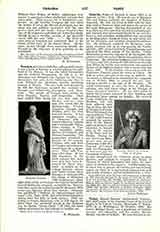
Roger Brooke Taney
Fifth chief justice of the Supreme Court of the United States, b. March 17, 1777; d. October 12, 1864

Taney, ROGER BROOKE (pronounced Tawney), fifth chief justice of the Supreme Court of the United States, b. in Calvert County, Maryland, March 17, 1777; d. at Washington, October 12, 1864. His father, Michael Taney, was a gentleman of Catholic ancestry and education, and his mother, Monica Brooke, was also a Catholic.
He was educated at private schools and by tutors until 15 years old, when he entered Dickinson College, Carlisle, Pennsylvania. He obtained his B. A. in 1795, and in the spring of 1796 went to Annapolis to read law in the office of Jeremiah Townley Chase, one of the chief justices of the General Court of Maryland. Early in 1799 he was admitted to the bar.
Returning to his father’s home in Calvert County to practice his profession, he shortly afterwards was elected to the House of Delegates, being then scarcely twenty-three years of age and the youngest member of the Assembly. In March, 1801, he went to Frederick to establish himself better in his legal practice, having been defeated for reelection to the Legislature from Calvert County.
He was a candidate for member of the House of Delegates from Frederick County in 1803 on the Federal ticket, but, the county being strongly Republican, he was again defeated. On January 7, 1806, he married Anne Phoebe Charlton Key, only daughter of John Ross Key, and sister of Francis Scott Key, a law student with Taney, at Annapolis, who afterwards wrote the “Star-spangled Banner”.
When General Wilkinson, then Commander-in-Chief of the United States Army, was tried before a court martial, convened at Frederick in 1811, on charges of being an accomplice of Aaron Burr, Taney was one of the counsel in his defense, and, together with John Hanson Thomas, succeeded in winning his acquittal. Both refused any fee for their service because they had shared the suspicion against the accused. Taney was defeated on the Federal ticket for member of the House of Representatives of the United States, but in 1816 was elected to the state Senate.
At the March term, 1819, of the Frederick County Court, he successfully defended Jacob Gruber, a Methodist minister, who was indicted for inciting slaves to the disturbance of the peace of the state. In 1823, he moved to Baltimore, and was soon recognized as the leading lawyer of that city, being appointed in 1827 by Governor Kent as Attorney-General of Maryland, upon the unanimous recommendation of the Baltimore bar. P
resident Andrew Jackson, a warm admirer of Taney, appointed him Attorney-General of the United States on June 21, 1831, and, upon the refusal of William J. Duane, Secretary of the Treasury, to remove the government deposits from the United States Bank, the president removed Duane from office on September 23, 1833, and, on the same day, appointed Taney in his stead. The latter assumed the duties of the secretaryship on the following day, and two days later gave the order for the removal of the deposits to take effect on the first of October following.
His appointment to the office of Secretary of the Treasury having been made during a recess of Congress, his nomination was sent to the Senate by the president on June 23, 1834, and was rejected after a heated debate. This was the first time in the history of the Government that a cabinet officer appointed by a president had been rejected. Taney immediately submitted his resignation to President Jackson, and the latter accepted it with much regret.
Judge Gabriel Duvall of Maryland, an associate justice of the Supreme Court of the United States, resigned in 1835, and President Jackson nominated Taney in his stead, but the nomination was not brought up in the Senate until the end of the session, and was then indefinitely postponed, which amounted to a rejection. This was due to the fact that the Senate as then constituted was violently opposed on political grounds to the president. In the same year Jackson again named Taney for a place on the Supreme Bench, this time as Chief Justice Marshall’s successor. The nomination was strongly opposed by Senators Webster and Clay, but was finally confirmed on March 15, 1836, by a majority of fourteen votes.
In the outbreak of yellow fever of 1855, Justice Taney’s wife, who never became a Catholic, was stricken and died at Old Point Comfort on September 29, and their youngest child died the following day.
The most famous case decided by the Supreme Court during Chief Justice Taney’s incumbency was that of Dred Scott v. John F. A. Sanford, the opinion in which, delivered by Taney, has been much misquoted and misunderstood.
Chief Justice Taney did much towards the building up of the system of practice in the Supreme Court, framing it after that of the English courts, yet so modified as to be adaptable to the changed conditions existing in the United States. His opinions were arrived at rather by deep reflection and application of established legal principles to the questions presented to him than through exhaustive research of authorities. While giving due respect to former decisions, he did not rely slavishly upon precedents.
By his dignified, though kindly, bearing, he always commanded the utmost respect for his Court. He had few, if any, personal enemies, and the purity of his private life was never questioned, even by his political opponents. Early in life he manumitted the slaves inherited from his father, and as long as they lived, he provided for the older ones by monthly pensions. He was buried at Frederick by the side of his mother’s grave, in accordance with his own request. There is a handsome statue of him in Mount Vernon Place, Baltimore.
J. P. W. MCNEAL


